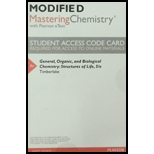
Concept explainers
(a)
Interpretation:
To write the balanced
Concept Introduction:
According to the law of conservation of mass the sum of the
(b)
Interpretation:
To write the balanced nuclear equation for the decay of Rn-222.
Concept Introduction:
According to the law of conservation of mass the sum of the atomic numbers and the sum of the atomic mases on the reactant side must be equal to the product side.
(c)
Interpretation:
If a room contains 24,000 atoms of radon-222, to find the number of atoms of radon-222 remain after 15.2 days.
Concept Introduction:
Radioactive decay equation:
where No is the initial activity, N(t) is the activity at time t, and t1/2is the half life of the radioactive substance.
(d)
Interpretation:
Suppose a room has a volume of 72,000 L. If the radon level is the maximum allowed (4 pCi/L), to find the number of alpha particles that are emitted from Rn-222 in one day.
Concept Introduction:
An arithmetical multiplier which is used for converting a quantity expressed in one unit into another equivalent set of units is said to be conversion factor.
The conversion factor used to convert Ci to pCi is as follows:
Want to see the full answer?
Check out a sample textbook solution
Chapter 16 Solutions
Modified MasteringChemistry with Pearson eText - Valuepack Access Card - for General, Organic, and Biological Chemistry: Structures of Life
 ChemistryChemistryISBN:9781305957404Author:Steven S. Zumdahl, Susan A. Zumdahl, Donald J. DeCostePublisher:Cengage Learning
ChemistryChemistryISBN:9781305957404Author:Steven S. Zumdahl, Susan A. Zumdahl, Donald J. DeCostePublisher:Cengage Learning ChemistryChemistryISBN:9781259911156Author:Raymond Chang Dr., Jason Overby ProfessorPublisher:McGraw-Hill Education
ChemistryChemistryISBN:9781259911156Author:Raymond Chang Dr., Jason Overby ProfessorPublisher:McGraw-Hill Education Principles of Instrumental AnalysisChemistryISBN:9781305577213Author:Douglas A. Skoog, F. James Holler, Stanley R. CrouchPublisher:Cengage Learning
Principles of Instrumental AnalysisChemistryISBN:9781305577213Author:Douglas A. Skoog, F. James Holler, Stanley R. CrouchPublisher:Cengage Learning Organic ChemistryChemistryISBN:9780078021558Author:Janice Gorzynski Smith Dr.Publisher:McGraw-Hill Education
Organic ChemistryChemistryISBN:9780078021558Author:Janice Gorzynski Smith Dr.Publisher:McGraw-Hill Education Chemistry: Principles and ReactionsChemistryISBN:9781305079373Author:William L. Masterton, Cecile N. HurleyPublisher:Cengage Learning
Chemistry: Principles and ReactionsChemistryISBN:9781305079373Author:William L. Masterton, Cecile N. HurleyPublisher:Cengage Learning Elementary Principles of Chemical Processes, Bind...ChemistryISBN:9781118431221Author:Richard M. Felder, Ronald W. Rousseau, Lisa G. BullardPublisher:WILEY
Elementary Principles of Chemical Processes, Bind...ChemistryISBN:9781118431221Author:Richard M. Felder, Ronald W. Rousseau, Lisa G. BullardPublisher:WILEY





